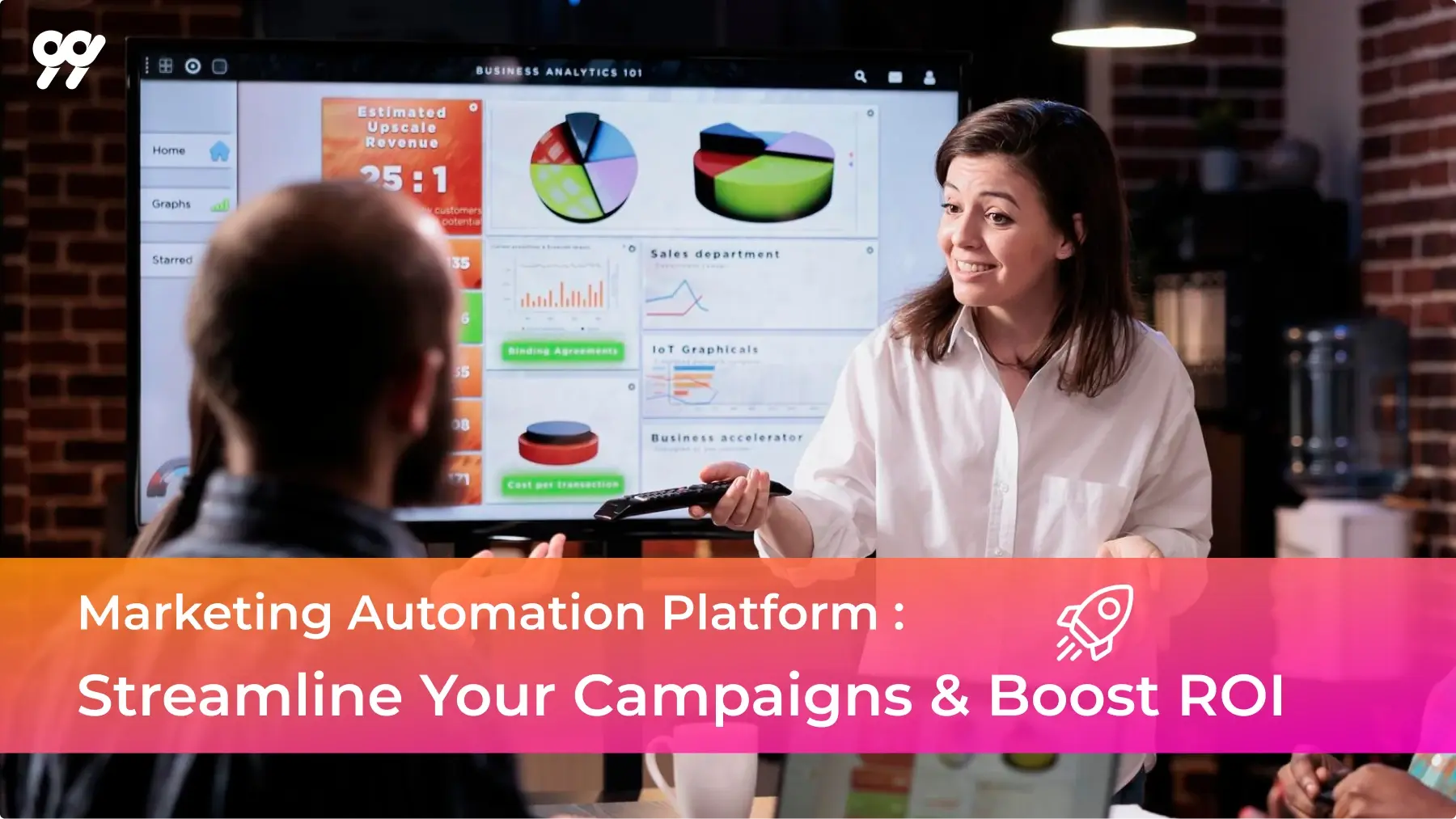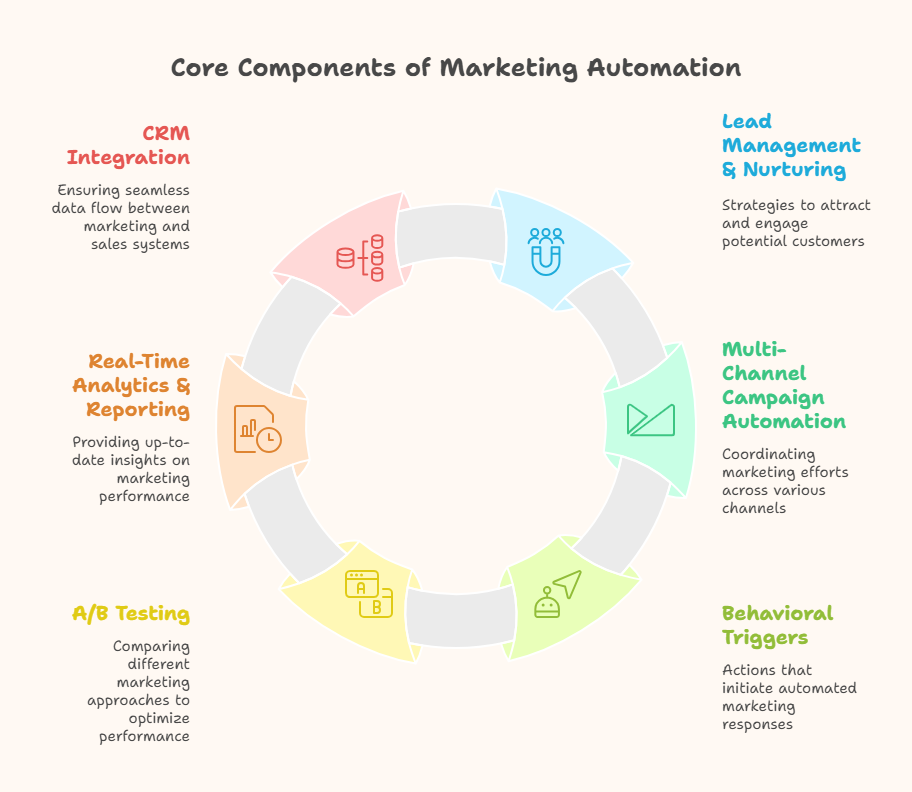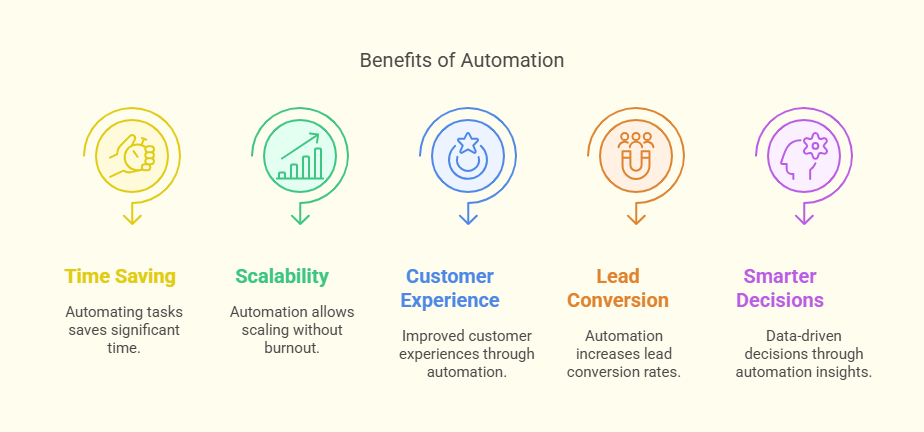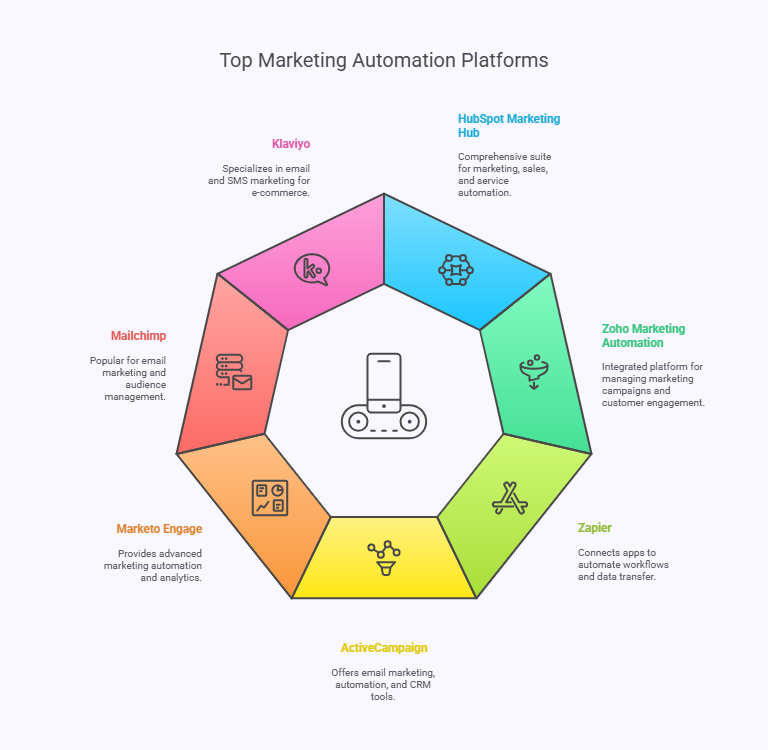
Let’s be honest—manually managing your marketing campaigns in 2025? That’s like using a flip phone in the age of iPhones.
We live in a time when customers expect fast, personal, and seamless experiences across emails, websites, social media, and messaging apps—you name it. Meeting those expectations without some serious tech help is not going to happen.
That’s exactly where marketing automation comes in.
Whether you’re a solo founder, a growing eCommerce brand, or a full-on marketing team, automating your workflows can save you hours, improve your results, and help you scale without burning out.
In this guide, we’re exploring marketing automation platforms, why they matter in 2025, the key features you should look for, the top tools on the market, and how to choose the best one for your needs.
Why Marketing Automation Matters in 2025?
You could run a basic email campaign a few years ago and get decent engagement. Not anymore.
Today’s customers are more innovative, impatient, and complex to impress. They expect relevant, real-time communication that feels made just for them. And they bounce fast if they don’t get it.
Marketing automation platforms have stepped up big time. In 2025, they will be more powerful, AI-driven, and user-friendly.
Here’s what you can do with a modern marketing automation tool:
- Talk to your customers across multiple channels.
- Personalize every message based on actual behavior.
- Get AI insights that show you what’s working (and what’s not).
- Save a ton of time by automating repetitive tasks.
- Scale your efforts without hiring a huge team.
Bottom line? Automation is how you stay competitive and agile in a digital-first world.
Think of a marketing automation platform as your behind-the-scenes marketing wizard.
It’s a software tool that helps you streamline, automate, and measure all marketing activities across different channels. Whether email, SMS, WhatsApp, or social media, these platforms allow you to create more innovative, efficient campaigns that run in the background while focusing on strategy.
What Can It Help With?
- Email marketing and drip campaigns.
- SMS and WhatsApp messages.
- Social media post scheduling.
- Landing page creation and A/B testing.
- Lead scoring and segmentation.
- Behavior-based triggers (like abandoned cart emails).
- CRM syncing to keep sales and marketing aligned.
It lets you do more with less—and reach the right people at precisely the right time.
Not all marketing automation platforms are created equal. If you’re shopping around for one—or trying to make sense of all the features—here’s a plain-English breakdown of what matters and why.
- Lead Management & Nurturing
Someone visits your site and signs up for a freebie (like a discount or ebook). Boom—you’ve got a lead! But now what? A good marketing automation platform lets you:
- Collect those leads through sign-up forms, exit-intent popups, or newsletter subscriptions.
- Tag and segment those leads based on their actions on your site (e.g., Did they check out shoes? Are they returning customers?
- Send personalized follow-ups automatically—like emails or SMS messages tailored to where they are in their buying journey.
Real-life example: Someone downloads your style guide. A few days later, they get a curated outfit suggestion email. That’s lead nurturing in action.
- Multi-Channel Campaign Automation
These days, people bounce between email, Instagram, WhatsApp, and your website without blinking. You’re missing out if your marketing only talks to them on one channel (like email).
Top platforms help you automate campaigns across:
- Email
- SMS and WhatsApp
- Push notifications
- Retargeting ads (on Facebook, Google, etc.)
- Social media posts
You can create workflows like “Send an email → wait 2 days → if no click, send a WhatsApp message → then show a Facebook ad.”
This keeps you visible without being annoying, and you reach your audience where they already are.
- Behavioral Triggers
Typically, where robotization gets truly keen, your stage can respond based on what individuals do rather than sending the same message to everybody.
Cases:
- Deserted Cart? Send an update 1 hour afterward.
- Gone to an estimating page? Trigger a case, I think about the mail to construct a belief.
- Went through 3+ minutes on a web journal? A pop-up appears advertising a free trial or demo.
It's all almost ideal timing and pertinence. Behavioral triggers guarantee that your messages reach them when they are intrigued.
- A/B Testing (a.k.a. Split Testing)
Let’s be honest: marketing often involves some guesswork. However, with A/B testing, you can replace your
guesses with actual data.
You can test things like:
- Subject lines (Is “Don’t miss this deal” better than “Just for you…?”)
- CTA buttons (Does “Buy Now” perform better than “Check it out”?)
- Email designs, image styles, and even entire automation workflows.
With this data, you can focus on what works and eliminate what doesn’t, automatically improving your results over time.
- Real-Time Analytics & Reporting
It’s one thing to run campaigns. It’s another thing to understand how they’re performing.
Your platform should give you insights like:
- Email performance: Who opened it? Who clicked? Who unsubscribed?
- Funnels: Where are people dropping off before converting?
- Revenue attribution: Which campaigns are making you money?
Access to this data in real time helps you tweak things as you go instead of guessing and hoping.
It’s like driving with GPS instead of a paper map. You know where you’re going and how to get there faster.
- CRM Integration (Keep Everyone in Sync)
Your sales and marketing teams should feel like a well-oiled machine, not two different planets. That’s where CRM (Customer Relationship Management) integration comes in.
Good marketing automation platforms sync seamlessly with tools like:
- HubSpot
- Salesforce
- Zoho CRM
- Pipedrive And others...
This allows you to:
- Share lead and customer data between departments.
- Track every touchpoint a customer has had with your brand.
- Align marketing campaigns with sales pipelines.
Example: If a lead watches your webinar, your sales rep can follow up the next day with a call or message, knowing their interest.

Why Your Business Needs Marketing Automation?
Let’s put it this way—trying to do all this manually is like running a marathon in flip-flops. Marketing automation gives you a pair of running shoes, a hydration pack, and a GPS tracker.
Here’s precisely why it’s worth it:
- You’ll Save a Ton of Time
You won’t need to send emails one by one or keep checking if someone clicked a link. Automation handles the repetitive stuff, freeing you (or your team) to focus on strategy and creativity.
- You Can Scale Without Burning Out
Whether you’ve got 100 leads or 100,000, your automated workflows can handle them without adding more stress or staff.
- You’ll Deliver Better Customer Experiences
People love feeling like a brand “gets them.” Automation allows you to send relevant messages based on what someone wants, not just what you want to promote.
- You’ll Convert More Leads
Timely follow-ups = warmer leads = more conversions. Period.
- You’ll Make Smarter Decisions
With built-in analytics and reports, you can see what’s working and make changes fast, so you don’t keep throwing money at underperforming campaigns.

Here’s a quick checklist:
- What’s your budget?
- Choose a platform that offers the best value without stretching your finances.
- Free tools are great for starters, but growing businesses may need premium features.
- Do you need CRM integration?
- Opt for a tool that syncs seamlessly with your existing CRM system.
- This ensures smoother data flow and better customer management.
- Is ease of use important?
- Look for a user-friendly interface to save time and reduce the learning curve.
- Teams without technical expertise will benefit from intuitive design.
- Do you need multi-channel capabilities?
- Pick a platform that supports email, SMS, social, and more if you market across channels.
- It helps you maintain consistent messaging and reach customers where they are.
- How extensive is your contact list?
- Make sure the tool can scale with your audience size and list segmentation needs.
- Some platforms charge based on contact volume, so plan for growth.
- Are you focused on B2B or B2C?
- Select a platform tailored to your audience type, whether it’s lead nurturing (B2B) or customer engagement (B2C).
- B2B often needs advanced automation, while B2C benefits from personalization tools.
Choosing the right tool comes down to matching features to your business needs.

There’s no shortage of marketing automation tools, but which ones are worth your time and money?
We’ve done the digging for you. Whether you’re running a startup, an e-commerce brand, or a growing B2B business, here are seven of the best marketing automation platforms you should seriously consider this year:
- HubSpot Marketing Hub
Best for: All-in-one CRM + marketing powerhouse.
Visit: HubSpot Marketing Hub.
HubSpot is hard to beat if you’re looking for a tool that does it all—from capturing leads to closing deals. It combines CRM, marketing, sales, and service tools in one clean platform.
Why people love it:
- Visual workflow builder makes automation easy, even for beginners.
- Native CRM means your marketing and sales data are always in sync.
- Lead scoring, email sequences, and innovative content targeting all in one place.
Pricing:
- Free plan available.
- Paid plans start at $45/month.
- Pro Tip: It’s perfect if you want to scale without switching tools.
- Zoho Marketing Automation
Best for: Budget-friendly promoting for tiny to mid-sized businesses.
Visit: Zoho Showcasing Robotization.
Zoho might not be as garish as others on this list, but it’s super capable and comes at a lovely cost. The integration is consistent if you currently utilize Zoho CRM or Zoho Mail.
What makes it great:
- Easy drag-and-drop campaign builder.
- Deep integration with other Zoho tools (CRM, campaigns, forms, etc.).
- Lead scoring and behavior-based segmentation at a fraction of the cost.
Pricing:
- Starts at just $10/month, making it ideal for startups.
- Pro Tip: A solid pick if you’re cost-conscious but still want pro-level automation.
- Zapier
Best for: Connecting your favorite apps to automate repetitive tasks.
Visit: Zapier.
Zapier isn’t a traditional marketing automation tool—it’s an automation MVP. It lets you connect over 6,000+ apps and automate any task across platforms.
Why it’s fantastic:
- Connect tools like Gmail, Slack, Mailchimp, Shopify, and Google Sheets.
- Create multi-step workflows without writing a single line of code.
- Super helpful for automating small but time-consuming tasks (like sending data from a form to your CRM).
Pricing:
- Free plan available.
- Paid plans start at $19.99/month.
- Pro Tip: Use it alongside other marketing tools to supercharge your workflows.
- ActiveCampaign
Best for: Email-first marketing automation with sales support.
Visit: ActiveCampaign.
ActiveCampaign could be an advertising favorite for its advanced automation features, especially if email is your primary channel. It’s designed for small to medium businesses that need more clever workflows and data-driven marketing.
What stands out:
- Profound e-mail personalization and behavior-based focusing.
- Visual computerization outline that’s shockingly instinctive.
- Built-in CRM, lead scoring, and even machine learning for predictions.
Pricing:
- Begins at a fair $10/month, making it perfect for new companies.
Professional Tip:
- A strong choice if you’re cost-conscious but still need pro-level mechanization.
- Marketo Engage (by Adobe)
Best for: Large businesses and enterprise-level automation.
Visit: Marketo Engage.
Marketo is a powerful platform designed for complex marketing operations. This tool is built for you if you’re running campaigns across multiple channels and large teams.
Why enterprises love it:
- AI-driven campaign execution with real-time personalization.
- Deep analytics, revenue attribution, and advanced reporting.
- Integrates well with Salesforce and Adobe tools.
Pricing:
- No public pricing—custom quotes only.
- Best suited for larger teams with big marketing budgets.
- Pro Tip: Marketo delivers serious performance and control if you manage millions in revenue and complex sales funnels.
- Mailchimp
Best for: Small businesses and solopreneurs getting started with email automation.
Visit: Mailchimp.
Mailchimp has evolved from a simple email tool into a versatile, all-in-one marketing platform. It’s a popular
choice for businesses just starting their automation journey.
Why it’s still a fan favorite:
- Easy-to-use drag-and-drop automation builder.
- Templates for welcome emails, abandoned carts, birthday messages, and more.
- Built-in landing page builder, surveys, and essential ad management.
Pricing:
- Free plan available.
- The Essentials plan starts at $13/month.
- Pro Tip: MailChimp is a great “starter” platform for basic email needs. It is easy to use and reliable.
- Klaviyo
Best for: E-commerce brands (especially those on Shopify, WooCommerce, or BigCommerce).
Visit: Klaviyo.
Klaviyo is tailor-made for e-commerce businesses. It delivers powerful automation and personalization tools for online retailers who want to grow revenue through smart messaging.
Why e-commerce brands love it:
- Pre-built flows for abandoned carts, welcome series, post-purchase, and win-back campaigns.
- Seamless integration with Shopify, Magento, WooCommerce, and more.
- Real-time customer data and predictive analytics.
Pricing:
- Free for up to 250 contacts.
- Paid plans scale based on contact count.
- Pro Tip: Use Klaviyo’s advanced segmentation to target high-value customers and drive repeat purchases.

Conclusion
In 2025, marketing automation isn’t just a bonus—it’s a necessity. As customers expect faster, more personalized experiences, businesses need innovative tools to keep up. Whether you’re a startup owner juggling multiple channels or an enterprise marketer handling thousands of leads, automation helps you stay efficient, relevant, and ahead of the curve.
Platforms like HubSpot, ActiveCampaign, and Klaviyo offer everything from behavior-based email sequences to AI-powered campaign optimization. And even if you’re just looking to stitch together your existing tools, Zapier provides a lightweight way to build intelligent workflows without needing code.
If you’re running an e-commerce business or managing loyalty programs, platforms like 99minds can be game-changers. By integrating seamlessly with tools like Shopify and other automation platforms, 99minds helps you personalize customer experiences, automate rewards, and drive repeat purchases—exactly the marketing agility needed in today’s competitive landscape.
If you haven’t adopted marketing automation yet, now is the perfect time to do so. Test a few platforms, find what fits your business, and build more innovative, scalable marketing systems today.
What is the difference between email marketing and marketing automation?
Email marketing is a subset of marketing automation. Automation platforms include email marketing but cover other areas like SMS, lead scoring, CRM integration, and behavioral tracking.
Can small businesses use marketing automation?
Absolutely! Tools like Zoho, Mailchimp, and Klaviyo offer affordable plans that are perfect for startups and small teams.
Is it difficult to set up marketing automation?
Most tools offer drag-and-drop builders and templates, making setup relatively easy even for beginners.
How do I measure the ROI of marketing automation?
Use built-in analytics to track key metrics like open rate, CTR, conversions, and revenue generated from automated workflows.





